Our Ancient Lakes by Jeffrey Mckinnon

Author:Jeffrey Mckinnon [McKinnon, Jeffrey]
Language: eng
Format: epub
Tags: Lakes; natural history; biodiversity; evolution; speciation; cichlids; adaptive radiation; nature travel; Baikal; Titicaca; Biwa; Tanganyika; Lake Victoria; Lake Malawi; Ohrid
Publisher: MIT Press
Published: 2023-09-27T00:00:00+00:00
The Transporter Hypothesis
Studies of smaller, younger bodies of water have advantages as evolutionary systems owing to the replication they sometimes provide and tractability of their smaller scales. Research on one inhabitant of such habitats, the threespine stickleback, is generating results that notably reflect and complement those emerging from ancient lakes. Stickleback lived in the drainage ditch in front of the house I grew up in, and I later did my PhD work with them, so I have a particular fondness for these prickly little creatures and their frantic, jerky courtship dances. Today they are probably the most extensively studied vertebrate in evolutionary biology even though, unlike the cichlids, they never form large species flocks.
What is special about the stickleback is that it has done certain things, including colonizing fresh water from the ocean, over and over and over again in thousands of different streams, rivers, and lakes on similarly extraordinary numbers of landmasses, from continents to tiny islands. In doing so, sticklebacks have evolved in parallel on a hemispheric scale, typically in response to lakes and streams opening up as glaciers retreated, but in a few instances finding newly available habitat when earthquakes moved coastal landscapes up and down. I have studied these charming fish in many locations, and one of my most memorable experiences was to see stream-resident stickleback in Gifu, Japan, for the first time. I knew that between British Columbia and Gifu, the stickleback of the Pacific Ocean were larger, bonier, longer spined, and more silvery than the dull little freshwater-resident fish scooting about the shallow streams of my hometown. Yet the Gifu fish, which my friend and collaborator Seiichi Mori showed me, could have been mistaken for the stickleback from the ditch in front of my parentsâ house. They were marvelous.
Considering freshwater sticklebacks from Japan, Europe, Alaska, and other distant locales, one might have guessed that the adaptations related to each freshwater colonization involved mainly different mutations, maybe even at different genes. A team led by Pam Colosimo in David Kingsleyâs lab at Stanford, collaborating with Dolph Schluter and his group, tested this possibility for one of the most conspicuous traits that often distinguish freshwater and marine sticklebacks: the bony plates along the side of the body. Marine stickleback have no scales, but possess prominent bony plates extending from just behind the head all the way to the tail. They look like the armored steeds of twelfth-century Europe, whereas the freshwater fish, especially in western North America, usually have just a few of these plates toward the head. Differences in predators and the relative cost of producing the plates probably contribute to selection favoring fewer plates in fresh water; the details are still debated somewhat, but what selection generally favors in each environment is clear. What is also clear is that plate genetics are unexpectedly simple.
In a series of experiments and comparative studies, Colosimo and her colleagues showed that a single gene, known as Eda, is responsible for much of the variation in bony plates. And
Download
This site does not store any files on its server. We only index and link to content provided by other sites. Please contact the content providers to delete copyright contents if any and email us, we'll remove relevant links or contents immediately.
The Lonely City by Olivia Laing(4768)
Animal Frequency by Melissa Alvarez(4424)
All Creatures Great and Small by James Herriot(4267)
Walking by Henry David Thoreau(3921)
Exit West by Mohsin Hamid(3794)
Origin Story: A Big History of Everything by David Christian(3665)
COSMOS by Carl Sagan(3585)
How to Read Water: Clues and Patterns from Puddles to the Sea (Natural Navigation) by Tristan Gooley(3430)
Hedgerow by John Wright(3314)
How to Read Nature by Tristan Gooley(3290)
The Inner Life of Animals by Peter Wohlleben(3284)
How to Do Nothing by Jenny Odell(3263)
Project Animal Farm: An Accidental Journey into the Secret World of Farming and the Truth About Our Food by Sonia Faruqi(3189)
Origin Story by David Christian(3170)
Water by Ian Miller(3155)
A Forest Journey by John Perlin(3042)
The Plant Messiah by Carlos Magdalena(2900)
A Wilder Time by William E. Glassley(2833)
Forests: A Very Short Introduction by Jaboury Ghazoul(2814)
